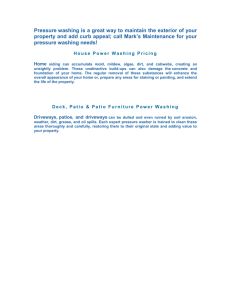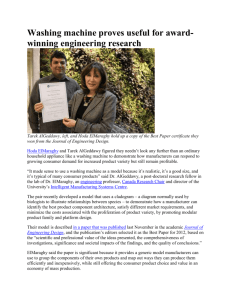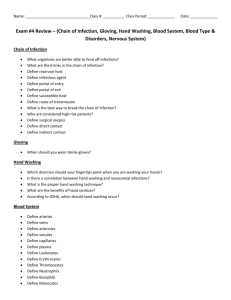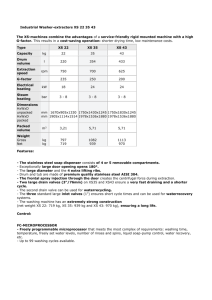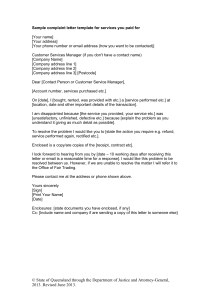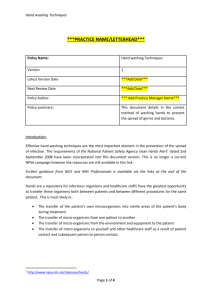Studies on the Washing of Paper: Part 2: A Comparison of Different
advertisement
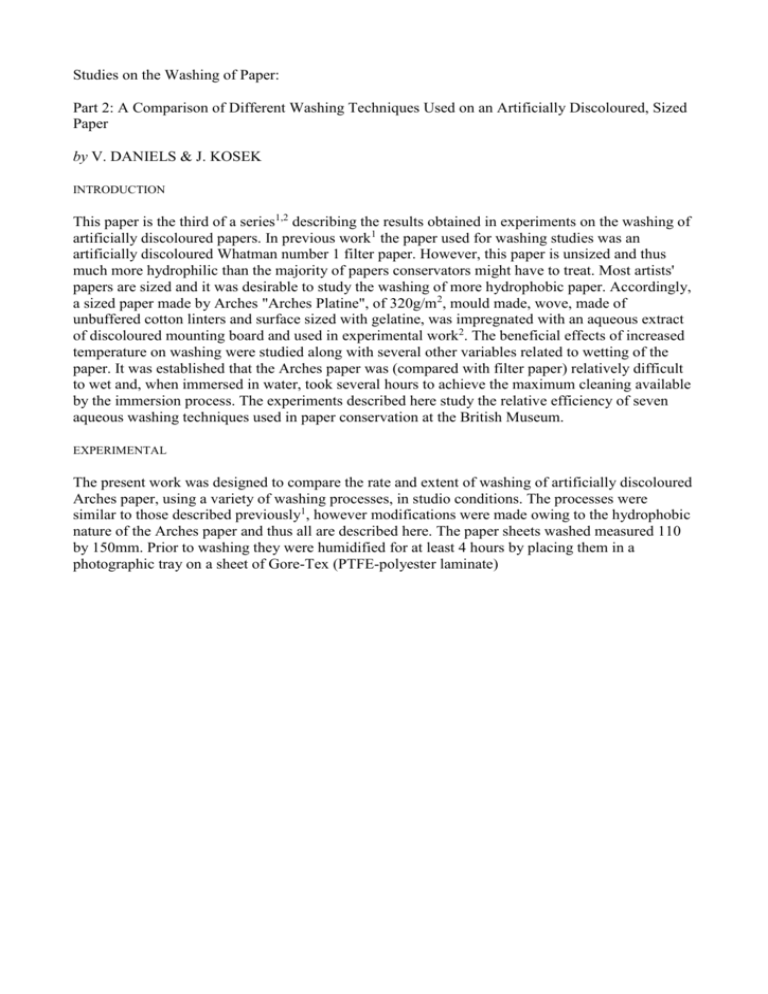
Studies on the Washing of Paper: Part 2: A Comparison of Different Washing Techniques Used on an Artificially Discoloured, Sized Paper by V. DANIELS & J. KOSEK INTRODUCTION This paper is the third of a series1,2 describing the results obtained in experiments on the washing of artificially discoloured papers. In previous work1 the paper used for washing studies was an artificially discoloured Whatman number 1 filter paper. However, this paper is unsized and thus much more hydrophilic than the majority of papers conservators might have to treat. Most artists' papers are sized and it was desirable to study the washing of more hydrophobic paper. Accordingly, a sized paper made by Arches "Arches Platine", of 320g/m2, mould made, wove, made of unbuffered cotton linters and surface sized with gelatine, was impregnated with an aqueous extract of discoloured mounting board and used in experimental work2. The beneficial effects of increased temperature on washing were studied along with several other variables related to wetting of the paper. It was established that the Arches paper was (compared with filter paper) relatively difficult to wet and, when immersed in water, took several hours to achieve the maximum cleaning available by the immersion process. The experiments described here study the relative efficiency of seven aqueous washing techniques used in paper conservation at the British Museum. EXPERIMENTAL The present work was designed to compare the rate and extent of washing of artificially discoloured Arches paper, using a variety of washing processes, in studio conditions. The processes were similar to those described previously1, however modifications were made owing to the hydrophobic nature of the Arches paper and thus all are described here. The paper sheets washed measured 110 by 150mm. Prior to washing they were humidified for at least 4 hours by placing them in a photographic tray on a sheet of Gore-Tex (PTFE-polyester laminate) laid onto water-sprayed blotting paper. The RH in the tray was approximately 100%. Immediately before washing each sample was lightly sprayed with water. Reverse osmosis purified water was used in the experiments. At the completion of the washing, the papers were placed on capillary matting to dry. Compared with our experiments on washing discoloured filter paper, the times of washing for several processes were increased in consideration of the lower washing rates and using times which would be typical of those used in conservation practice. Immersion washing The paper was placed on a support of thick Bondina (non-woven polyester tissue) and immersed in 2.0 litres of water in a small photographic tray. Because the paper floated it was held down in the water by a glass weight placed at the very edge of one of the short sides. At intervals the water was gently moved by rocking the tray. Typically, there was one water change every 15 minutes. Before water changes and at the end of the process, the sample was removed by lifting the support by one edge and allowing excess water to drip off. Float washing The paper was placed on a support of thin Bondina and the latter placed in contact with the surface of a water bath so that both floated. Surface tension and air trapped in the paper keep the assemblage afloat. Water was changed with the same frequency as in immersion washing and the sample, on its support, was transferred onto the surface of a water bath in another tray. Blotter washing A sample was placed on a pile of 6 thick, multisorb blotting paper sheets which had been cut 20mm larger each side than the sample. They were placed in a 200mm x 250mm photographic tray and 550ml water poured into the tray so that the level of water was still below the top piece of blotting paper. The absorbed water came up to the top sheet but did not flow over its recto. The sample on thin Bondina was placed on the pile of blotting paper and the discolouration diffused into the top sheets. Blotting papers were not changed for the 1 hour wash. They were changed once for the 3 hour wash, and two times for the 5 hour wash. Diffusion-mist washing A pile of dry blotting paper was placed in a photographic dish and covered with a sheet of glass. Ultrasonically generated water mist was directed towards the top of the pile through a tube. To encourage initial contact with the paper to be treated, the top two sheets of blotting paper were sprayed with water before the paper, on thin Bondina tissue, was placed on top. The sample was not moved again until the end of the treatment. Discoloured material is drawn into the uppermost layers of blotting paper and afterwards migrates to the lower layers. In one treatment the volume of water used by the mist generator was typically 280 ml/ hour. Suction with mist A sheet of blotting paper was placed on a Willard vacuum table followed by a sheet of thin Bondina and the sample paper to be cleaned. Sheets of latex were laid at the edges of this assembly so that a gap of 2mm was still open for the passage of air. A plastic dome of about 0.012 m3 volume was placed over the sample and ultrasonically generated mist fed into the dome via a side-arm. The suction table was operated at 35 mbar. There were no blotter changes for the 30 minute wash, one for the 1 hour wash and two for the 3 hour wash. In one treatment, the volume of water used by the mist generator was typically 170 ml/hour. Suction with sprayed water The above experiment was carried out except that the hood with mist was replaced by sprayed water in fine droplets applied at intervals by the conservator. The application of water was 25ml for the half-hour treatment, 50ml for the hour treatment and 200ml for the 3 hour treatment. The Chinese method The Chinese method used in previous work1 was not thought to be usable on paper of this kind because of the thickness and the difficulty with which it wetted. Following the consultation with conservator of Chinese art on paper, Jin Qiu, the method was altered to consist of a series of short immersions in about 1000ml of hot water. The water, which had just been boiled, was poured into a stainless steel tray and the sample held down with tweezers until it stayed submerged. The wash lasted 7 minutes and the temperature was approximately 85°C at the onset of the wash and 65°C at the finish. Three samples were washed: the first for 7 minutes, the second was washed in two 7-minutes baths and the third was washed in three 7-minutes baths. Samples were placed on capillary matting between the changes of wash water. EVALUATION Preliminary experiments showed that the starting material was less reproducible and that the rate and extent of cleaning of the Arches paper was lower than for the filter paper. The loss of discolouration was followed by measuring the 1976CIE L*a*b* values of the samples using a Minolta CR-300 tristimulus col-ourimeter. This instrument had the advantage over our spectrophotometer in that no sample needed to be removed from the sheet for insertion into the apparatus, enabling multiple measurements to be made on large sheets before and after washing. Each sheet was measured on both sides and at each corner i.e. eight measurements in all. The b* parameter (which corresponds to yellowness) was the one which underwent most change, thus it was decided to use that to follow the washing. In many conservation studies of colour change, the value of AE is used in preference to the change in L*, a* or b*, however a change in AE does not indicate whether the yellowness has increased or decreased. It will be seen that both increases and decreases of discolouration occur in the samples studied and the use of b* is preferred. It is estimated that a change of ΔE of about 1.7 is visible to the average observer3, (this is presently under review). A change of b* would give a change of E of the same magnitude if there were no change in a* or L. In practice a* and L do change and the change in E will be larger than the change in b*. RESULTS Table 1 shows the results for the washing trials separately for the recto and verso (upper and underside of the paper) during treatment. Δb* = b* before washing minus b* after washing. Thus a positive Δb* indicates cleaning, while a negative Ab* indicates that the paper became more discoloured. Here the error on the b* readings is estimated as +0.05, and all results exceed this value. Table 1: Yellowness of the treated samples. DISCUSSION The Chinese method is undoubtedly the fastest and most effective conservation cleaning method, probably because of the elevated temperatures used. Warmer water has been demonstrated to produce more effective washing1,2. The observation that the paper did not float in the water bath at the end of the Chinese washing process indicates effective wetting. By comparison, after a five hours immersion wash in ambient temperature water the paper would still be floating. Some processes appeared to move the discolouration and concentrate it on one face of the paper, fn blotter and float washing the recto (in conservation washing this is usually the image side of a piece of paper) ended up less clean than it was initially. However, in some suction treatments and the diffusion mist method, the verso ended up more discoloured than it was at first. This behaviour may be explained by the soluble discoloured materials concentrating at the driest surface of the paper where removal is most difficult. For the conservator, these observations are a warning that some processes used for washing a work of art could end up producing an image visibly less clean than it was to start with even though the total discolouration in the object had decreased. This hazard is greater in papers which are difficult to wet. This work has demonstrated the value of using "real" paper in addition to filter paper in a study of paper conservation processes. The Arches paper was thick and hydrophobic and washed very slowly when compared to filter paper. SUMMARIES Studies on the Washing of Paper, Part 2: A Comparison of Different Washing Techniques Used on an Artificially Discoloured, Sized Paper Seven different conservation washing techniques have been used for cleaning artificially discoloured Arches paper. The new paper was much more hydrophobic than the discoloured filter paper used by the authors in previous work. Washing was much slower and some techniques appeared to redistribute and concentrate discolouration on one surface of the paper, making it more discoloured than at the start of the process. The Chinese method produced the most efficient washing probably due to the higher temperatures used. Etudes sur le lavage du papier, 2"" Partie : une comparaison de differentes techniques de • utilisees sur un papier encolle, decolore artificiellement Sept differentes techniques de lavage de conservation ont ete utilisees pour nettoyer du papier a aquarelle « Arches » decolore artificiellement. Le nouvcau papier utilise etait beaucoup plus hydrophobe que le papier filtre decolore utilise par les auteurs dans les experiences precedentes. Les techniques de lavage se sont effectuees beaucoup plus lentement et certaines d'entre elles ont eu pour resultat que la decoloration se concentre a la surface et se redistribue autrement qu'avant la procedure de lavage. La methode chinoise de lavage s'est revele etre la plus efficace, pro-bablcment a cause des plus fortes temperatures utilisees. Untersuchungen zum Wässern von Papier 2: Ein Vergleich verschiedener Techniken, an-gewandt aufkunstlich verfcirhtes geleimtes Papier Künstlich verfärbtes Aquarellpapier ,,Arches" wurde sieben verschiedcnen konservatorischen Waschmethoden unterworfen. Das Material war weitaus stärker wasserabweisend als das ver-färbte Filtrierpaper, das in des Autors früherer Untersuchung verwcndet wurde. Die Wasch-vorgänge liefen wesentlich langsamer ab, und einige hatten zur Folge, daß sich die Verfärbung auf der Oberfläche konzentrierte und anders verteilte, was einen stärkeren Verfärbungseindruck hervorruft als vor dem Wässern. Die chinesische Methode erwies sich als die wirkungsvollste, wahrscheinlich wegen der für sie charakteristischen erhöhten Temperatur. REFERENCES 1. Daniels, V., &J. Kosek: The rate of washing of paper. In: Works of Art on Paper Books Documents and Photographs, Techniques and Conservation, ed. V. Daniels, A. Donnithorne & P. Smith,: London: International Institute of Conservation 2002: 47-51. 2. Daniels, V., & J. Kosek.: Studies on the washing of paper, part 1: the influence of wetting on the washing rate of paper. Restaurator 25,2 (2004): 81-93 3. Ashley-Smith, J, A. Derbyshire & B. Pretzl: The continuing development of a practical lighting policy for work of art on paper and other object types at the Victoria and Albert Museum. ICOM Committee for Conservation, 13* Triennial Meeting Rio de Janeiro, ed R. Vontobel. Rome 2002: 38. V. Daniels* Conservation Department Royal College of Art Kensington Gore London SW7 2EU UK daniels2@ntlworld.com J. Kosek Western Art on Paper Department of Conservation, Documentation and Science, The British Museum London WC1B3DG UK * Author to whom correspondence should be addressed ERRATA In the first part of Studies in the Washing of Paper (pp. 81-93 of this volume) unfortunately an error has crept in. The text on p. 90, end of second paragraph starting on line 19 should have read as follows: nominally 0 or 100%. The samples gave the following mean reflectance increases: • 6.3,5% ± 0.85 (0%RH) • 6.20% ± 1.01 (50%RH) • 5.92% ± 1.16 (100%)RH.
